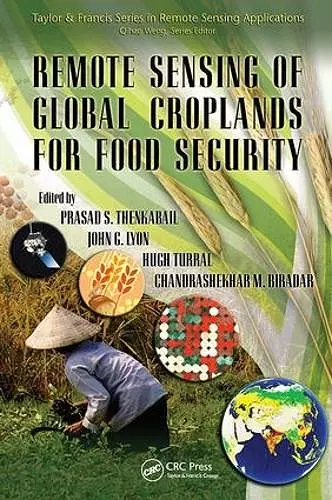Remote Sensing of Global Croplands for Food Security
John G Lyon editor Prasad Thenkabail editor Hugh Turral editor Chandrashekhar Biradar editor
Format:Paperback
Publisher:Taylor & Francis Ltd
Published:14th Nov '18
Currently unavailable, and unfortunately no date known when it will be back
This paperback is available in another edition too:
- Hardback£200.00(9781420090093)

Increases in populations have created an increasing demand for food crops while increases in demand for biofuels have created an increase in demand for fuel crops. What has not increased is the amount of croplands and their productivity. These and many other factors such as decreasing water resources in a changing climate have created a crisis like situation in global food security. Decision makers in these situations need accurate information based on science. Remote Sensing of Global Croplands for Food Security provides a comprehensive knowledge base in use of satellite sensor-based maps and statistics that can be used to develop strategies for croplands (irrigated and rainfed) and their water use for food security.
Over 50 Multi-disciplinary Global Experts Give Insight and Provide Practical Approaches
Emphasizing practical mapping technologies based on advanced remote sensing data and methods, this book provides approaches for estimating irrigated and rainfed cropland areas and their water use on a national, continental, or global basis. Written by 50+ leading experts working at the forefront of this critical area, it offers case studies from a variety of continents highlighting the subtle requirements of each. In a very practical way it demonstrates the experience, utility, and models for determining water resources used and resulting yields of irrigated and rainfed croplands. The authors discuss: (a) innovative methods used for mapping croplands, (b) approaches adopted to collect cropland data in different countries by traditional and non-traditional means, (c) accuracies, uncertainties, and errors involved in producing cropland products, (d) surface energy balance models used to assess crop water use, and (e) extensive results and outcomes pertaining to global croplands and their water use.
Develop Strategies for an Enhanced Green Revolution and an Accelerated Blue Revolution
Linking croplands to water use and food security, the book provides a global perspective on this sensitive issue. It gives insight into the extent of cropland usage, their spatial distribution, their cropping intensities, and their water use patterns. The editors collect the experience, methods, models, and results that show the way forward and help in decision-making on water resources and food security. All of this is required for developing strategies for an enhanced green revolution and for an accelerated blue revolution.
… provides unique means for understanding and comparing different cropland mapping strategies by utilizing different satellite sensors and ancillary data sets. The chapters are well written for entry level through advanced level remote sensing or agricultural specialists, and each chapter can be read sequentially or separately. … thoroughly documents the techniques and error assessment methods utilized to develop the world's first global irrigated map derived from remote sensing data. … the numerous international authors, color plates, and national cropland statistical tables makes the book an attractive and authoritative reference for mapping global croplands from remote sensing data.
—Curt A. Reynolds, Crop Analyst, Foreign Agricultural Service, USDA, Washington, D.C., in Photogrammetric Engineering & Remote Sensing, June 2010
ISBN: 9781138116559
Dimensions: unknown
Weight: 816g
524 pages